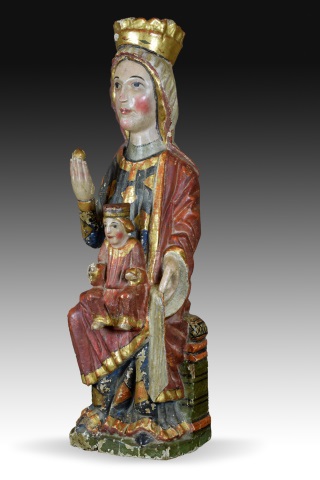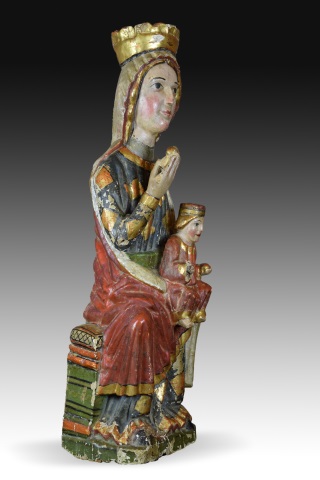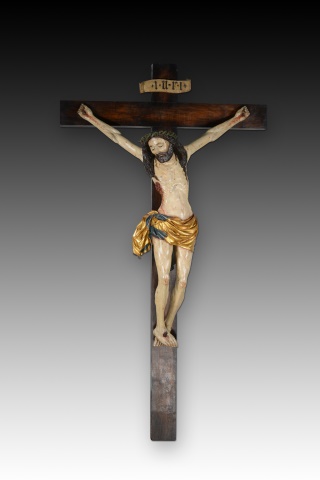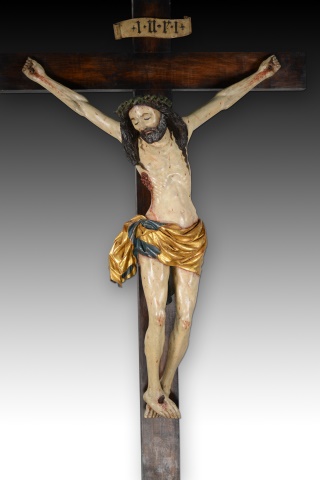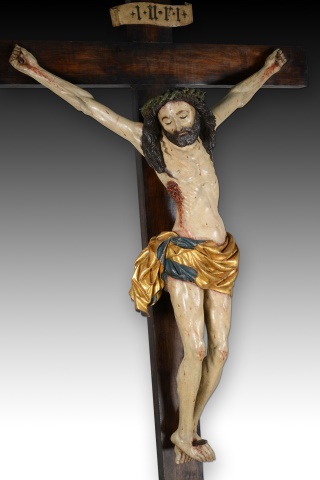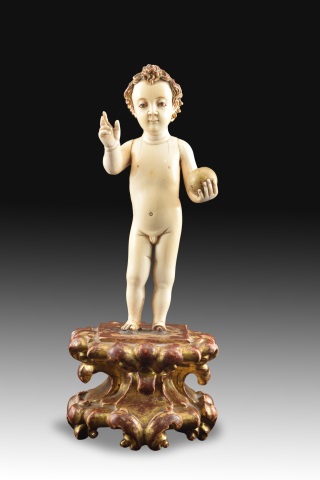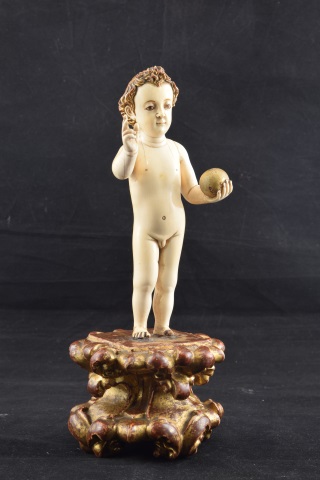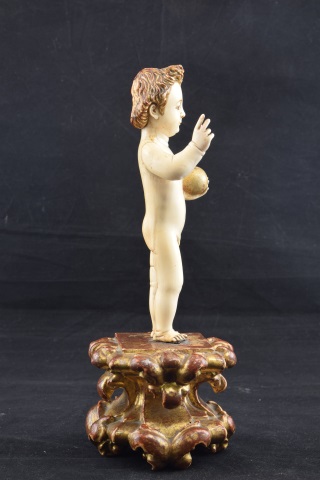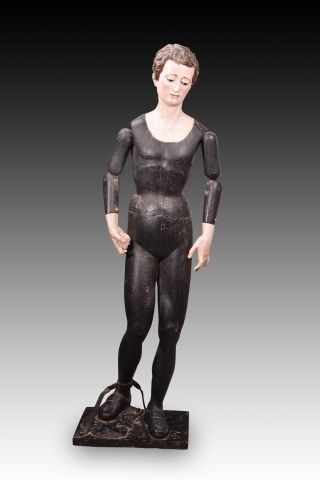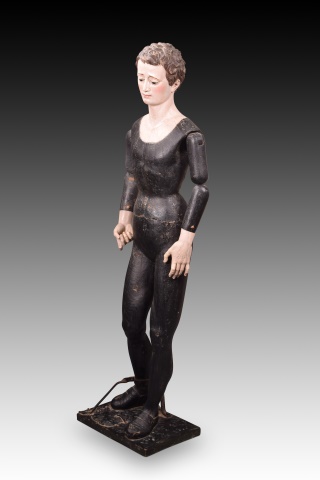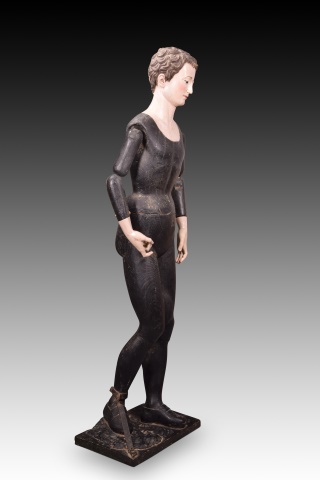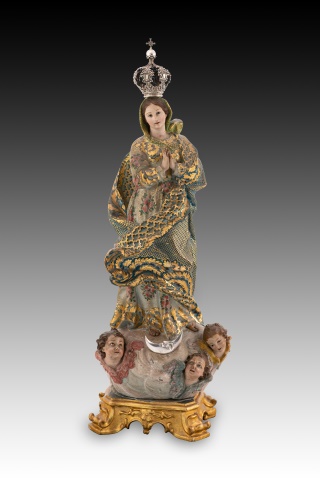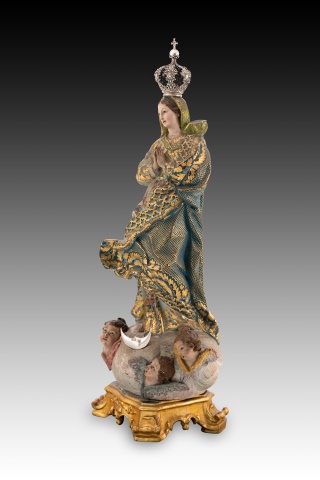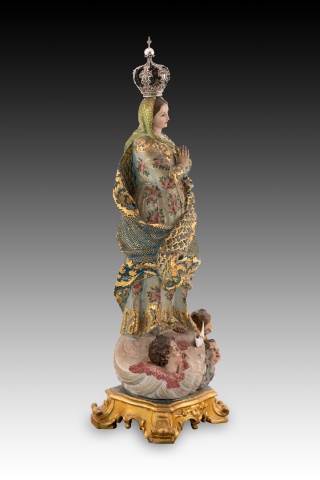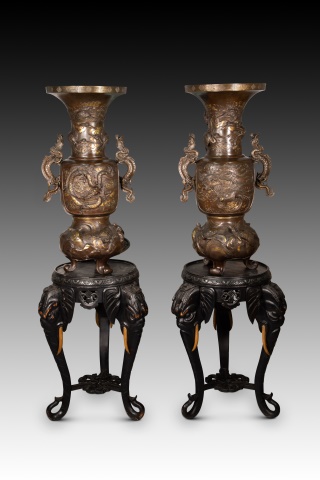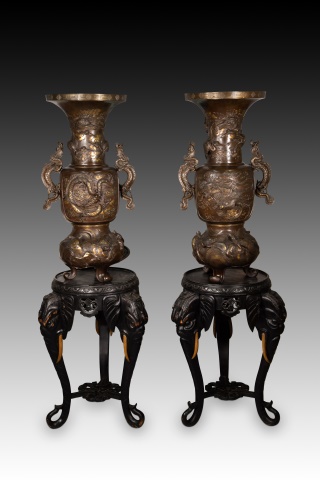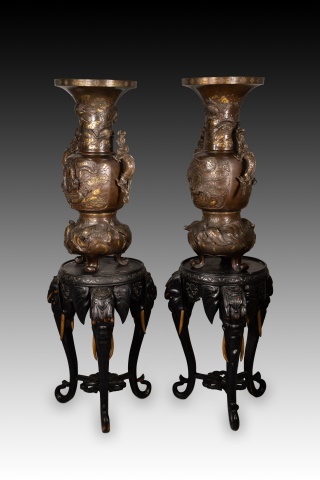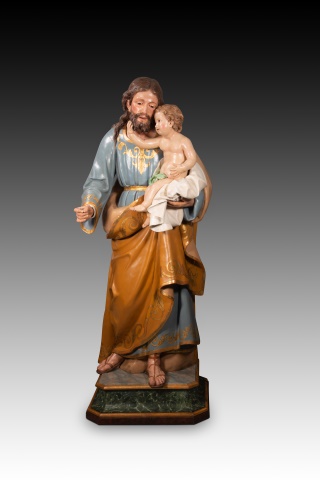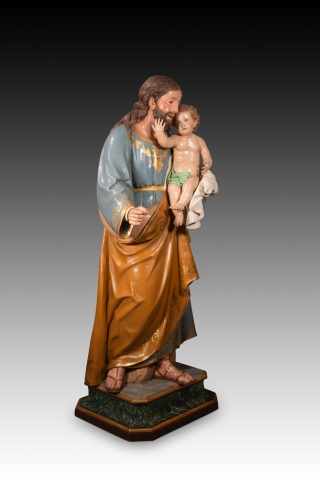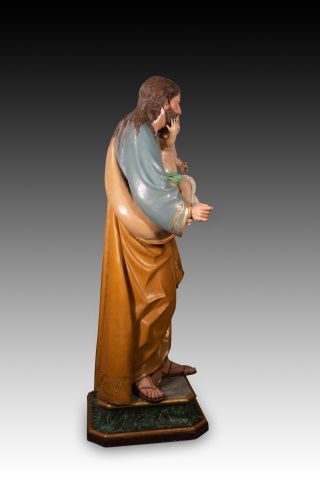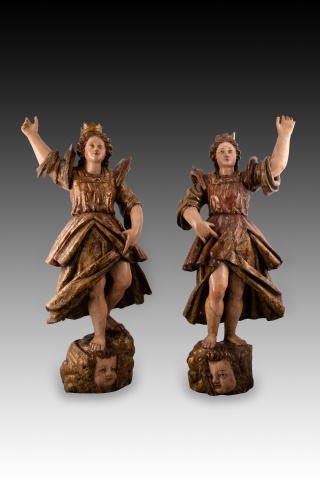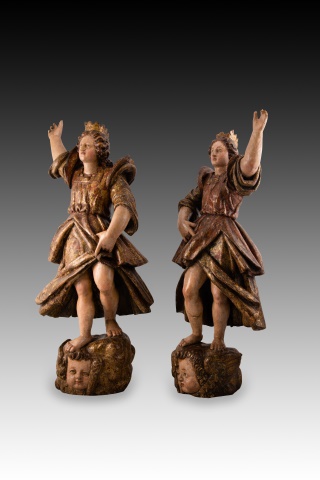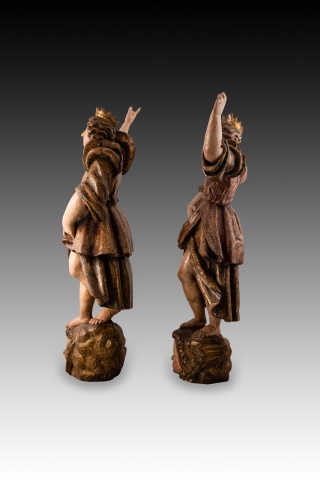
-
TWO RELIEFS, EVANGELIST SAINTS JOHN AND MATTHEW. POLYCHROMED AND GILT ...
Pair of reliefs, Saint John and Saint Matthew. Polychrome wood. Possibly from the Burgos school, 16th century. Pair of reliefs made of carved and polychrome wood, each showing a human figure sitting and writing, surrounded by books and accompanied by a figure respectively. One, with black hair and a beard, is accompanied by another winged child figure who brings him an inkwell; the second, younger (beardless) and with blond hair, is shown concentrating on a scroll, while an eagle brings him an inkwell with one paw, resting on one of them. As is appropriate for this type of subject, each of the Evangelists is usually accompanied by the corresponding figure of the four that make up the Tetramorph. Thus, Saint John is shown with the eagle and Saint Matthew with the “winged man”. Both are shown surrounded by books, in interiors decorated with gilded furniture and seated on high-backed chairs or thrones. Note the vegetal scrolls on the books, furniture and walls, accompanied by candelieri elements and fish or dolphin heads, in compositions reminiscent of those found in Renaissance works. This classicist influence can also be seen in the figures (faces, folds, anatomy, posture, etc.) and in the environment they occupy (for example, the mouldings and scrolls on the seats and desks, or the aforementioned decoration on the bindings of the books that appear in both works). The iconography that appears in this couple is frequent in Spanish art of the period, often situated in the lower part of altarpieces (Main Altarpiece of Foncea, Burgos school). Compare, for example, with Saint John the Evangelist of the Main Altarpiece of the Assumption of Ullíbarri Viña (execution attributed to Juan de Ayala II, painted before 1579 by Juan de Oñate) in the Basque Country, where three books also appear in a loft in the background; or, to see a different composition, with the set of four Evangelists attributed to Felipe Bigarny (dated between 1501 and 1525) from the Castilian school of the National Sculpture Museum (Valladolid); or with the relief of Saint Mark from the altarpiece of Saint Eulalia by Markinez or Marquinez in the Diocesan Museum of Sacred Art in Vitoria-Gasteiz (its sculpture attributed to the workshop of Juan de Ayala II and the polychrome to Santos Corres, the sculpture dated in the second half of the 16th century and the polychrome in 1747). In addition to Felipe Vigarny, in the Burgos area it is necessary to take into account Bartolomé Ordóñez and Diego de Siloé (two of the most important names of the first third of the 16th century), together with masters such as Juan de Balmaseda, Andrés de Nájera, Juan de Juni (who also worked in the city), etc.ANTIQUES
· Size: 72x4x99 cms.
Ref.: ZF0662A -
VIRGIN WITH CHILD. POLYCHROMED WOOD. SPANISH SCHOOL, 13TH CENTURY.
Virgin and Child. Carved and polychrome wood. Spanish school, 13th century. It has faults. Polychrome wooden carving showing the Virgin sitting on a throne, with her right hand raised holding a spherical object, dressed in a long tunic and cloak and wearing a veil and crown, also holding on one knee the Child, who is shown sitting on one of his mother's knees, dressed in a red and gold tunic and also a crown on his head. Iconographically, this type of work was common during the Romanesque period in Europe, a time when Christian theology saw the Virgin as a vehicle of Salvation, thanks to the figure of her son Jesus. Over time (and the theological work of highlighting the role of Mary as Mother of God), the initially hieratic pose of this group varied, an example of which is the present sculpture. Compare with Our Lady of the Snows of Villaumbroso in Palencia (14th century), or the Virgin of Mirón in Soria (carving from the 14th century), or the repainted Virgin of the Cerca de Andosilla in Navarre (13th-14th centuries), or the one in the church of San Pedro Apóstol de Arbués in Huesca which has been dated to the 14th century (similar to the one present on the throne, the crowns, the posture of Jesus, etc.), or the one from the last third of the 13th century which belongs to the collections of the Prado Museum in Madrid, the one from the Rosary of Villálvaro in Soria (14th century), etc.ANTIQUES
· Size: 28x20x90 cms
Ref.: ZE087 -
THE ABDUCTION OF THE SABINE WOMEN. BRONZE. 19TH CENTURY, AFTER GIAMBOL...
Rape of the Sabine Women. Bronze. 19th century, modeled after Giambologna (Juan de Bolonia; Douai, 1529–Florence 1608). A patinated bronze sculpture made using the lost-wax casting technique featuring a small, also dark, polygonal base. The three human figures are situated on a small rock surface, thus enhancing the complex interplay of diagonals and spirals created by the postures of the two men and the woman, positioned at the top of the composition. Considered Juan de Bolonia's masterpiece, the Rape of the Sabine Women is a sculpture created between 1581 and around 1582. It measures 410 cm in height, is carved from a single piece of marble, and is located in the Loggia della Signoria (Florence, Italy). It depicts a young man lifting a woman over his head, who struggles to free herself from him, while an old man appears between the boy's legs. It is because of this popularity, apart from its quality, that bronze casts of the work and works inspired by it were made even during the artist's lifetime, and, of course, during the Grand Tour and destined, above all, for England and Germany, in various sizes (almost always much smaller than the original). A bronze reduction of the work is attributed to the work by Pietro Tacca, preserved at the Honolulu Academy of Arts; another, dated to the 18th century, is preserved at the Metropolitan Museum of Art in New York.ANTIQUES
· Size: 37x38x114 cms.
Ref.: ZF0789 -
CORPUS CHRISTI. POLYCHROMED WOOD. POSSIBLY SOUT GERMANY, 15TH CENTURY.
Crucified Christ, Sorrowful Crucifix. Carved and polychrome wood. Possibly South German school, 15th century. Polychrome and gilded wood carving showing Christ with the Crown of Thorns, on the Cross, already deceased (eyes closed), with the usual INRI phylactery on the upper crossbar of the Latin cross, three nails (note the crossed feet) and a short, gilded and polychrome purity cloth or perizonium. In German, the term “Gabelkreuz” or “Gabelkruzifix” (“Sorrowful Crucifix” in English) refers to a type of Gothic crucified Christ that is especially expressive (prioritizing external suffering over other aspects) and which normally presents the cross in the shape of a Y or ypsilon (alluding to the Tree of Life), apparently created thanks to the influence of the mysticism of the late 13th and early 14th centuries (Saint Bridget, etc.) and which can be found in the Rhineland (western Germany) and, through influences and contacts, in the rest of Europe (apparently, there are those who currently consider that the origin of the iconography is not German but Italian). Most of the sculptures of this type are concentrated in three European areas: the German zone, which includes the current federal states of northern Rhineland-Westphalia, Rheinland-Pfalz, Lower Saxony, and central and northern Italy, although they are also found in other enclaves such as Lucera in Puglia, Palermo in Sicily, and Oristiano in Sardinia. Nor should we forget the Spanish examples (usually included in three categories: those derived from the Holy Christ of Perpignan, the Castilian group, the Navarrese images, and the Andalusian Crucifixes). One of the oldest pieces that follows this typology is the Doloroso Crucifix from the Church of Santa Maria del Capitolio in Cologne. In Italy, the one from the Church of Santa Maria Novella in Florence is often highlighted. In Spain there is one in Puente la Reina (Navarre) that is considered to have been donated by a German pilgrim in the 14th century; There is one in the lower choir of the monastery of Santa María de las Huelgas Reales in Burgos, attributed to a Central European workshop or to a sculptor influenced by these models in the second half of the 14th century (with a Latin cross). It is also necessary to take into account the German sculptors who travelled and worked in Europe.ANTIQUES
· Size: 76x26x135 / 62x23x85 cms.
Ref.: ZF1176 -
SAINT HUBERT OR SAINT EUSTACE. GOLDEN AND POLYCHROMED WOOD. SPANISH S...
Possibly Saint Hubert or Saint Eustace. Carved, polychrome and gilded wood. Spanish school, 16th century. Polychrome and gilded wooden carving, simply polished on the back, showing a richly dressed young rider, wearing a flat hat, and with a falcon on his right arm, his hand covered with a glove. Iconographically, it could be a civil sculpture of a nobleman on a hunt, given that he does not wear a halo and there are no other elements that identify him. However, it could also be a saint. In this case, it could be Saint Eustace of Rome, a Roman general martyred in the Italian capital during the persecutions of Emperor Hadrian in 118 AD and who was converted when, out hunting, he saw a deer with a crucifix between its antlers, illuminated by a strong light and heard a voice warning him. This vision also appears in the lives of St. Felix of Valois (saintified in 1666), who had it while he was walking, and St. Hubert of Liège (a Merovingian nobleman who took up hunting after his wife died, and had the aforementioned vision while hunting on Good Friday, with a voice that told him "Hubert, if you do not return to the Lord and lead a holy life, you will go to hell" and sent him to find the bishop of Maastricht, Lambert, where he converted, renouncing his position and giving his wealth to the poor). St. Hubert died in Tervuren, Brabant, and his remains ended up in the Abbey of Andain, in the current town of St. Hubert, his remains being lost in the 16th century (until then the abbey was a very important pilgrimage centre). The importance of this saint was increased thanks to some Military Orders that took his name in the 15th century; in addition, Philip IV of Spain had him as a protector. Normally, these saints (Saint Eustace and Saint Hubert) are shown accompanied by a deer with a cross or a crucified Christ between its antlers, as this was the most important moment of their lives. However, when there was more space or development at various times in history, it was not unusual to see them with a horse: the portal of the chapel of Saint Hubert in Amboise (chapel built between 1491 and 1496), with the saint next to a horse and kneeling before the deer; two works preserved in the Metropolitan Museum of New York: a French relief from the beginning of the 16th century with the saint mounted on horseback (inventory 25.120.284) and a half prayer bead from the beginning of the 16th century, from the Netherlands, with the saint also mounted. Representations of Saint Eustace are less numerous, in principle. Stylistically, the work does not show much Hispano-Flemish influence (although the saint was very popular in northern Europe). Also, compare the attire: the hat is similar to the one worn by the portrait of John Calvin in the engraving attributed to Hans Holbein the Younger (ca. 1497-1543).ANTIQUES
· Size: 64x20x77 cms
Ref.: ZF0950 -
CLOCK SET. BRONZE, ROUGE GRIOTTE MARBLE, GLASS. FRANCE, 19TH CENTURY, ...
Clock mount and two candlesticks. Bronze, red griotte marble. France, 19th century, following Clodion's models. Set or garnish consisting of a table clock and two candlesticks with two lights each, made of burnished and gilded bronze and rouge griotte marble, as well as other materials. The clock, raised on legs, has a marble base enhanced with gilded bronze elements in a strong classicist style, like the rest of the decoration; the Paris machinery of the clock has been placed inside a rectangular box of bronze and transparent glass, topped by a composition of flowers, leaves and a torch at the top, and the dial (white with Arabic numerals for the hours and every 15 for the minutes, on a garland of flowers) is signed “P. Lombardi / AParis”; next to this gilded structure, there is a child figure in burnished bronze in a dark tone, with wings on its back. The two candlesticks, raised on legs and bases of the same marble enhanced with a chain of gilded bronze pearls, present figures in dark-coloured burnished bronze and two “branches” with grapes ending in containers with garlands for candles. The two candelabras, depicting a satyr and Bacchus or a bacchante, were inspired by pieces created by Claude Michel (1738-Paris, 1814), a French sculptor known as Clodion, who won awards such as the Grand Prix for sculpture from the Academie Royale in 1759, the Prix de Rome in 1762, etc., and was highly appreciated for his work. The satyr in this pair closely follows models by the master (compare Satyr Running with an Owl, made between 1770 and 1780, Cleveland Museum of Art) and there are several examples of candelabras with figures like this pair (with variations in the lights and bases). The Cupid on the table clock is also inspired by Clodion's reliefs and sculptures, but what is striking about this fitting is that it is not at all usual to combine candlesticks with these figures with the clock in the same set. Weight: 16 kg (clock); 6 kg (candlesticks).ANTIQUES
· Size: Reloj 28x24x45 cms. Cand. 18x13x31 cms.
Ref.: ZF0790 -
CHILD JESUS SAVIOUR OF THE WORLD, HISPANO-PHILIPPINE. IVORY. 17TH CENT...
Infant Jesus of the Ball. Ivory. Hispano-Philippine School, 17th century. Infant Jesus made of carved ivory, polychrome in some specific areas and placed on a carved and gilded wooden base. It has very pronounced curves and movement, and a very studied decoration based on plant elements. Iconographically, this figure of the Infant Jesus standing, holding the Orb of Creation in one hand and blessing with the other, is known as the “Boy with the Ball”, and has a strong relationship with that of the Salvator Mundi, known among others for paintings such as that of Leonardo da Vinci but very common already in the late European Middle Ages (the adult Salvator Mundi would appear in northern Europe in the second half of the 14th century). The present piece responds to the popularization of a large number of iconographies of the Infant Jesus that occurred in the Baroque. Nudity is usual in this type of sculptures, as they are works conceived to be dressed and adorned with velvet, silk, embroidery, silver, etc. Aesthetically, it is related to examples from the 17th century Spanish Baroque school. Note the hairstyle, which is slightly reminiscent of the work of Martínez Montañés, to name one. Compare, for example, with the Children preserved in the “Sala Marfiles” of the Museum of Mexican History in Monterrey (Nuevo León, Mexico), or with the 17th century ivory Filipino Infant Jesus from the Museum of America in Madrid, or the 18th century Hispano-Filipino from the Patricia Phelps de Cisneros Collection preserved in the Middlebury College Museum of Art (Vermont, United States). Religious carvings made of ivory were doubly appreciated for the prestige and richness of the material and for their subject matter in an era like the Baroque, which was focused on the defence of Catholicism in some areas and was eager to show power and influence like all others. In this case, it is also necessary to take into account the “exotic” factor, as it is a Hispano-Filipino piece: along with the peninsular influence, it is possible to see the “touch” of the Filipino artists (Chinese settled in the islands, locals, etc.) in these works with somewhat slanted eyes, bulging eyelids, etc. Although they were sometimes made and commissioned for private chapels of the upper classes of the time, it is common for this type of sculpture to have been preserved in religious centres of great importance, where they have been found as donations. It has a CITES certificate. Valid for the European Union.ANTIQUES
· Size: 11x11x29 cms. Altura niño 20 cms.
Ref.: ZF0601 -
SAINT ALOYSIUS DE GONZAGA (TO DRESS UP). POLYCHROMED WOOD, ETC. SPANIS...
San Luis Gonzaga, dressing room. Polychrome wood, etc. Spanish school, 18th century. A sculpture made of polychrome wood, which shows, on a rectangular base, a young man without a beard, with a black body and a polychrome face, neck, hands and part of the arms. This treatment is common in sculptures created to be dressed (note also the arms articulated at two points each – shoulder and elbow). Attached to one ankle is an old piece of metal and two nails in the feet, which could be an old reinforcement that, in turn, suggests that the work was carried in a procession (there is another piece with screws in the head). As is common in this type of work in the Spanish school since the Baroque, the eyes are made of glass. Saint Aloysius Gonzaga (Castiglione delle Stiviere, 9 March 1568 – Rome, 21 June 1591) was an Italian Jesuit priest canonised in 1726 by Benedict XIII, who declared him patron saint of youth. While in the service of Philip II, he married a lady of Queen Isabella of Valois; he also served in the Spanish court as a page to Prince Don Diego, heir to the monarch, but ended up ceding his rights as first-born to his brother to enter the Society of Jesus (novitiate in Rome in 1583), despite his father's efforts to prevent it. He died after caring for people affected by the plague in this Italian city. He is represented as a young man dressed in a black cassock and surplice or as a young page. His attributes are a lily, referring to his innocence; a cross, referring to his piety and sacrifice; a skull, referring to his early death; and a rosary, referring to his devotion to the Virgin Mary.ANTIQUES
· Size: 39x26x134 cms.
Ref.: ZE427 -
IMMACULATE CONCEPTION. WOOD, SILVER, GLASS. PORTUGUESE SCHOOL, 18TH CE...
Immaculate Conception. Carved and polychrome wood, glass, silver. Portuguese school, 18th century. Sculpture made of wood showing a young Mary, with her hands together in front of her chest in an attitude of prayer, and standing on a cloud, from which emerge winged angel heads and on which there is a “false” (a silver crescent moon with a face on both sides). Dressed in a tunic, the cloak appears waving, the garments decorated with flowers, waves, etc., combining polychromy and gilding. She has a crown, in silver in its colour, with architectural and plant elements of strong classicist influence, which does not show contrasting marks. Under the cloud, there is a rectangular pedestal, made of gilded wood and decorated with architectural and plant elements in relief. Note that it is also worked on the back, where a label appears after the completion of the work. Given its iconography, it is believed to be a carving of the Immaculate Conception. It is one of the most common models for depicting the Virgin in Spanish Baroque art, and is also common in other schools (where reference is usually made to the Virgin of the Conception or the Immaculate Conception). This devotion presents an iconography whose development began in Spanish Gothic art, responding to a desire to highlight the purity of the Mother of Christ. In its beginnings, it presented details of the Vision of Saint John on Patmos and elements belonging to the Marian Litanies, becoming simpler over time. Stylistically, the movement and certain details of the mantle show a certain influence of Rococo, an artistic movement that originated in France (where it developed between 1730 and 1760) and which spread from there to other European schools. There is evidence of the existence of a sculpture quite similar to the one present in the Portuguese Nossa Senhora da Vila, Nossa Senhora do Bispo e Silveiras (officially: União de Freguesias de Nossa Senhora da Vila, Nossa Senhora do Bispo e Silveiras), Évora, dated to the second half of the 18th century and considered to be from the Portuguese school, although no further details have been found about its authorship. This sculpture also has a base similar to that of this sculpture.ANTIQUES
· Size: 21x15x56 cms
Ref.: ZF1324 -
”SAINT ROCH”. POLYCHROMED AND GILT WOOD SCULPTURE. JUAN DE ANCHIETA WO...
“San Roque”. Sculpture in polychrome and upholstered wood. Surroundings of Juan de Anchieta, 16th century. A bearded male figure stands, holding a book and wearing a pilgrim's hat on his back, and is shown showing his right leg and resting his foot on a quadruped with something in its mouth. To his right, a naked child looks towards the saint while touching the saint's leg with his left hand. The image is shown with the angel on his left, the plague wound or bubo on his leg (normally, the one he shows is the other one), the pilgrim's hat and cloak and the dog with the loaf of bread placed under one of his feet in a very unusual way. All these attributes help to identify the image with Saint Roch, an Occitan pilgrim canonised in 1584 who was highly venerated before this date, above all, for being considered a healing saint, especially in cases of pestilence. The influence of the Italian Renaissance can be clearly seen in the sculpture: that of Michelangelo in the corporeality and anatomy of the two figures, the expressiveness of the saint, the composition, etc. These details, together with other peculiarities such as the hair and the proportions, allow us to relate the sculpture to the workshop of Juan de Anchieta (Azpeitia, ca. 1533 - Pamplona, 1588), a sculptor of great importance in 16th century Spanish art with work in northern Castile, Aragon, the Basque Country, Navarre and Burgos, and considered one of the leading figures of Romanism. It is believed that he trained in Italy, hence his stylistic connection with certain works by Jacopo della Quercia and, above all, his inspiration from the works of Michelangelo. The influence of the focus of Valladolid is also clear in his style, where he is documented between 1565 and 1570. Compare, for example, with the altarpiece of the church of San Pedro de Zumaia (Pamplona), finished in 1577, the commissions he carried out for the Cathedral of Burgos between 1576 and 1578 (Coronation of the Virgin and carving of Mary located above the choir lectern), or the main altarpiece of the Parish of Santa María de Tafalla carried out between 1581 and 1583. He set up his workshop in Pamplona, with numerous commissions, and his style was so appreciated that it would influence works carried out in Aragon throughout the first third of the 17th century.ANTIQUES
· Size: 16x11x25 cms.
SCULPTURERef.: ZE062 -
PAIR OF VASES WITH SIDE TABLES. BRONZE, WOOD, ETC. JAPAN, MEIJI PERIOD...
Pair of vases with elephant-headed bases. Bronze, wood, etc. Meiji period (1868-1912), Japan; Anglo-Indian school, towards the end of the 19th century. Pair of patinated bronze vases made up of several pieces, raised on three curved legs and decorated on the outside with reliefs of animals and mythological beasts, enhanced with gold details and bands of geometric motifs. They have metal containers that fit into the upper part. On both bases there are turtles with waves creating waves; on the central body, handles in the form of dragons and phoenixes on one side and dragons on the other; on the neck, more birds (herons or similar) flying among clouds. The bases are two side tables made of ebonized wood with elephants (heads decorated to resemble textile ornaments, with light-colored tusks) functioning as legs by curving the trunk outwards, an openwork chamfer, an openwork waist to secure the furniture and a top decorated with carvings and flat boards. These types of vases were one of the so-called "export" items, having been manufactured with the sole purpose of being sold to foreigners in the Meiji Era (1868-1912) of Japan, named after the reigning Emperor and in which the country began its modernization and westernization, establishing itself as a world power thanks to a certain openness to foreigners (presence and ideas), changes in the government, etc. Dragons are the most powerful symbol of all the animals in Japanese art, considered to be divinities related to water, and to which, for example, the change of seasons was attributed (when they flew through the sky it was spring). The crane and the turtle symbolize longevity, with the first animal in flight (in the upper area) associated with the sky and the second with the lower area (of a kimono, for example) linked to the earth. As for the elephant-headed side tables, it should be noted that they were highly prized pieces of furniture by the British during part of the colonial period in India (1858-1947), with numerous examples imported to the United Kingdom, including those found in Buckingham Palace and other noble residences. Note the quality of the present pair, which can be clearly seen in the animal carvings and plant motifs that complete the table. In Hindu iconography, the elephant is associated with wisdom, divine knowledge and royal power.ANTIQUES
· Size: 60x60x165 cms.
Ref.: ZF1280 -
GILT BRONZE PAX BOARD. POSSIBLY ROME, LAST THIRD 16TH CENTURY-FIRST TH...
Peace-bearer, Pietà. Gilded bronze. Possibly Rome, last third of the 16th century-first quarter of the 17th century, following the model of Michelangelo Buonarroti. Gilt bronze plaque with an S-shaped handle on the back attached to an L-shaped piece decorated with plant elements, which has reliefs on the front. The architectural frame has two curved pediments as a finishing touch between which God the Father appears blessing, a series of motifs around the central theme and a flat base with fine mouldings on which a winged angel's head appears. This central motif is an image of the Virgin Mary with the dead Christ supported by two angels, which closely follows a drawing attributed to Michelangelo Buonarrotti dated between 1538 and 1544 and preserved in Boston (Isabella Stewart Gardner Museum). It should be remembered that, by the mid-sixteenth century, Michelangelo's Pietà to which we refer was widely known thanks to drawings, reliefs, engravings, etc. There is also evidence of a bronze peace-bearer made with this image (the one preserved in the Basilica della Santa Casa in Loreto is considered to be the only known example dated 1586), which gave rise to a notable production in Rome at the end of the 16th century, full of prominent foundries among which Jacopo (who worked with Michelangelo) and Ludovico Duca would stand out, linked to some of these peace-bearers. It is also worth noting the similarity of the architectural composition of this piece with the entrance to the façade of the church of Santa Maria di Trivio in Rome, a work by Jacopo del Duca carried out between 1573 and 1575. Compare this piece with the gilt bronze peace-bearer in the Bernard d'Agesci Museum in Niort, France (inventory 914.1.94), with another associated with the circle of Stefano Maderno preserved in a private collection (different handle to this one), with the aforementioned one from Loreto and with another, with openwork exterior decorative elements, also in a private Italian collection.ANTIQUES
· Size: 11x5x17 cms.
Ref.: ZF1166 -
DANCER WITH SNAKE OR CLEOPATRA. BRONZE, MARBLE. DEVENET,
Dancer with a snake or Cleopatra. Bronze, marble. DEVENET, Claude-Marie (1851-Paris, 1931), ca. 1925. With brand. Bronze figure on a pyramidal pedestal of veined stone showing a young woman in exotic clothing, crouching, holding a snake in her hands. Stylistically, it presents details that allow it to be considered within the Art Deco style and, as for the subject, there are known pieces in which she appears as a dancer and others that link the scene with the death of Cleopatra at the hands of the asp. A disciple of Auguste Dumond at the École des Beaux-Arts in Paris, Claude-Marie Devenet was awarded a Third Class Medal at the Salon of 1882, and a Bronze Medal at the Universal Exhibition in Paris in 1900. Weight: 3.4 kg.ANTIQUES
· Size: 10x8x32 cms.
Ref.: ZF1194 -
”MADONNA WITH CHILD AND ANGELS”. BRONZE AND LAPIS LAZULI. ITALY, 15TH-...
Relief “Virgin and Child with Angels”. Italy, 15th-16th centuries. Bronze in its color and gold, lapis lazuli, rock crystal, enamel. In the centre of the work, the enthroned figure of Mary is shown, with a cloak over her shoulders and hair and holding the Child on her knees, who appears to be addressing one of the angels. The Virgin is also sheltered by an ogee arch supported by turned columns and elevated visually by steps. This composition achieves a very striking contrast: the figure in dark bronze, in contrast with the lapis lazuli background and the part of the arch and its exterior, in gilded bronze. Below the steps appears a heraldic shield in enamel with a key on an azure background. The kneeling angels are flanking this figure, and, as they appear in dark bronze, they visually share the “category” of religious figures with Mary, while their (lower) position gives greater status to both the Mother and Jesus. The rest of the composition is completed with a delicate landscape: buildings and walls on mountains, clouds in the sky, plants, stones, etc. Towards the outside, there is another lapis lazuli frame decorated in the corners with appliqués, giving way to the carved and polychrome wood frame. Lapis lazuli is a semi-precious stone that was already known in the 7th millennium BC, found in deposits from the Caucasus to Mauritania. From the end of the Middle Ages, its export to Europe increased, and it was used more frequently since then both as a pigment in paintings after being ground (giving rise to the finest and most expensive of blues, and of colours in many cases), as a background for paintings, inlays in works of art, jewellery and, a little later, in the well-known “hard stone works”. The figure of Mary still shows an influence of Gothic models, although more European than Italian, together with elements that could already indicate a closeness to the Renaissance: although the nakedness of Jesus is already shown in Gothic works (Madonna with Angels by Fra Angelico), the creation of space by means of the play with the cloth in front of Christ can be appreciated in more advanced paintings (Madonna and Child by Domenico Ghirlandaio, National Gallery, London); the presence of a powerful throne can frequently be seen in Italian Madonnas of the Quattrocento (and before), but not quite as it is presented here. As for the landscape, it should be compared, for example, with that of the fresco by Condottiero Guidoriccio of Fogliano (Simone Martini, finished in 1328). This is a work of great technical and aesthetic quality, not to mention the materials chosen for its creation, comparable only to outstanding examples from around the world, such as those preserved in the Palazzo Madama in Turin (Italy), in which coral also plays an important role. Also worth mentioning are works such as the plaque of hard stones (lapis lazuli among them) with a relief of Mary and Child in bronze, made around 1580-1600 in Italy and preserved in the Art Institute of Chicago; or the “Panorama della Piazza della Signoria” (Jacopo Bilivert, ca. 1599) from the Pitti Museum; or the “Banquet of the Gods”, based on a design by Guglielmo della Porta, preserved in the Metropolitan Museum of New York.ANTIQUES
· Size: 20x22,5x3,5
Ref.: ZF0123 -
PAIR OF CHILDREN. POLYCHROMED PINE WOOD. 18TH CENTURY.
Pair of children. Polychrome pine wood. 18th century. Pair of polychrome pine wood carvings depicting two children playing a wind instrument, both seated, with their hands towards their faces, and slightly raising one leg to add some movement to a posture that would otherwise be perhaps too static. Given their postures and attitudes, they would have been part of a large, high-quality altarpiece, judging by the carving, the details, the hair, the proportions, etc., elements in which musical angels were not unusual. Note that the angels present do not have wings, and in these cases are called “putti” and are, in the same way, figures that are commonly present in religious settings despite having emerged from Renaissance classicism and its sources from Antiquity. The proportions of the sculptures, the anatomy, the symmetry, the certain plasticity of the hair, etc. are elements that speak of a Neoclassical influence in these sculptures. Likewise, a certain resemblance can be seen with works from the 18th century of the Castilian school.ANTIQUES
· Size: 22x42x85 cms / c/peanas 37x37x180 cms
Ref.: ZF0594 -
PAIR OF POLYCHROMED WOODEN SCULPTURES. “SAINTS APOSTLES JOHN AND PAUL”...
Pair of polychrome wooden sculptures. “Saint John and Saint Paul”. Castilian school, 16th century. Both male figures are depicted standing, with their main iconographic attributes and dressed in the timeless tunics that the period reserved for sacred persons. The younger one holds a chalice in his hand, from which a snake emerges, and an eagle at his feet; the bearded man holds a sword with the hilt visible. The first is Saint John, with the Tetramorph eagle alluding to his Gospel, and the chalice related to the episode of the Golden Legend of James of the Voragine in which he tells how the Emperor Domitian tried to kill him with poisoned wine, which escaped in the form of a snake after the evangelist blessed the cup. The second is Saint Paul, with that characteristic appearance that relates him to much earlier paleo-Christian works and with the sword of his martyrdom, which also refers to a text from his Letter to the Ephesians. Stylistically, both devotional carvings in the round show a marked Italian Renaissance influence in the drapery, contrapposto, proportions and gestures, distancing the works from the other trend of the time which was closer to Flemish models, which preferred greater drama. Gothic has been left behind, as demonstrated by the naturalness of the faces, folds, anatomy and gestures, after much effort. It was necessary to first accustom the clientele to the new tastes and for the artists to learn the technical and aesthetic novelties that the arrival of the Renaissance entailed, and it developed in different periods and at very different levels depending on the region or the artist. Compare the works, for example, with the San Juan de circo by Juan Rodríguez from the Fundación Simón Díaz (work housed in the Museo de las Ferias in Medina del Campo, Valladolid).ANTIQUES
· Size: 26x26x76 cms.
SCULPTURERef.: Z3642 -
CHILD JESUS. WOOD. SPANISH SCHOOL, 17TH CENTURY.
“Baby Jesus”. Carved and polychrome wood. Spanish school, 17th century. Later pedestal. Christ is presented naked, with a slight contrapposto in the legs and hips that give some movement to the sculpture and with delicate flesh tones. He keeps his gaze fixed forward, while raising one arm in an attitude of blessing, and holds a golden orb alluding to Creation with the other hand. His curly, blond hair has a tuft in the centre of his head. The sculpture is enhanced by a pedestal, modern but inspired by Spanish Baroque models, formed by lines with a lot of movement and decorated with architectural elements of classical influence, among which the pairs of protruding volutes from the fronts stand out. Although the forelock is reminiscent of the works of Martínez Montañés, in this example the hair is clearly curly. Compare this work with works such as those preserved in the Museum of Fine Arts in Córdoba, with one in the Municipal Museum of La Roda, some from the Royal Monastery of Las Descalzas in Madrid, etc. This type of work was made to be worn, and was normally intended for a female religious setting (it was considered that female devotion should not be directed towards certain works or iconography of the Passion because it was too strong), or some private oratory in some important residence.ANTIQUES
· Size: 41x32x87 cms
Ref.: Z6564 -
”VIRGIN WITH CHILD ON THE THRONE”. BOXWOOD, BRONZE AND ROCK CRYSTAL. 1...
Enthroned Virgin and Child. Boxwood, bronze and carved rock crystal. 19th century. On a padded base, there is a second base made of bronze, the metal from which the throne is made. It stands on four low columns with smooth shafts and capitals decorated with scrolls and simplified plant forms, decorative elements that are repeated at the waist, combined with oval blue beads; the backrest, square and openwork with very schematic scrolls, is topped with four carved rock crystal pearls. The Virgin Mary is seated on it, with a crown that repeats the decorative elements of the throne, dressed in a tunic and cloak and with a book in her hand. The Child Jesus, on her lap, also looks forward, while blessing with his right hand. The iconography comes, as usual, from Byzantine models: among the types of Theotokos, the Panakranta or Panacranta is the one in which Mary appears seated on a throne, with the Child on her lap and both facing the spectator, showing what was agreed at the IV Ecumenical Council of Chalcedon (451 AD). These arrived in Europe already in the Romanesque, developing the iconography of the West. The present work can be compared with the Italo-Byzantine icon of the 13th century preserved in the National Gallery of Art in Washington DC (United States), or the carving of the "Virgin of the Battles" of the Monastery of San Pedro de Arlanza, made around 1225-1235, and preserved in the Museum of Burgos, or the Romanesque one from the mid-17th century today in the Museum of Fine Arts of Buenos Aires (Argentina), although there are a large number of examples. However, details such as the decoration of the capitals, the anatomy shown by the two figures, the scrolls of the throne and the crown, the folds of the draperies, a certain air in the faces despite their schematization, the symmetry present in various points of the work, etc., show that the carving belongs to a date closer to the present. Specifically, to the style known as Neo-Gothic: this was inspired by works from the 13th to the 15th-16th centuries and was opposed to the preceding Neoclassical style; it was born in England towards the middle of the 18th century, and spread throughout continental Europe in the 19th century.ANTIQUES
· Size: 10x10x24 cms
SCULPTURERef.: Z6707 -
”RESSURRECTION”. POLYCHROMED WOOD. SPANISH SCHOOL, 16TH CENTURY.
Resurrection of Christ. Carved and polychrome wood. Spanish school, 16th century. On one side of the piece there is a relief with the theme of the Resurrection of Christ: Jesus, dressed in the golden shroud, appears in the middle of a beam of light and clouds, standing over the tomb and raising one arm while holding with the other hand a staff topped with a cross and a flag waving in the wind; on the lower part there are four soldiers, in different postures and attitudes. The other side shows a chalice with a Holy Host (in which a Crucified Christ appears flanked by the Virgin and Saint John in grisaille), raised by two angels; all the elements are placed on a golden background, in a space surrounded by clouds; on one side there is a piece of wood on which, originally, there would have been a bolt, and on the other there are remains of two hinges. It is this element that makes one think that the relief was surely a door of a Tabernacle. The piece follows a decoration that is common in Renaissance and Baroque tabernacles. Compare, for example, with the 17th century altarpiece of the main altar of the church of the Monastery of Santa Isabel in Madrid, or with others preserved in private collections. The scene of the Resurrection recalls in details such as the variety of postures of the soldiers, the anatomy of Christ, the movement of the shroud around his body, etc. outstanding pieces such as the 16th century relief in Renaissance style in the Museum of the Monastery of the Cistercian Abbey of Cañas in La Rioja. Although they are parts of an altar with varied themes, the emphasis is always on Salvation, since they are intended to contain the Holy Host.ANTIQUES
· Size: 32x5x52 cms.
Ref.: ZF0280 -
ESCUTCHEON. ALABASTER. SPAIN, 17TH CENTURY
Heraldic shield. Carved alabaster. Spain, 17th century. Quartered shield with seven Moorish heads facing the centre, adorned on the border and a bird on the crest. The first quarter is checkered or chequered with chains in orders of three and five; the second quarter is quartered with towers and chevrons with a pendant; the third quarter is a saltire bordered with seven saltires of Saint Andrew; the fourth quarter is with three horizontal bands. It is crowned by a feathered knight's helmet facing left, and is flanked by a composition of grotesques with busts, volutes and architectural elements on the hats of the human figures; below, another bust flanked by vegetal and architectural elements. The composition corresponds to models common in the 17th century, maintaining a marked classicism. Compare, for example, with the one in the Casa de Begoña de Agurain, one in the Barrio del Cantero in Barcenillas (Cantabria), etc.ANTIQUES
· Size: 103x110 cms.
Ref.: ZF0793 -
FRIEZE. POLYCHROMED PINE WOOD. 16TH CENTURY.
Frieze with reliefs. Carved and polychrome pine wood. 16th century. Rectangular frieze of carved, gilded and polychrome pine wood decorated with figurative reliefs. An architectural piece with a garland serves as the axis for the symmetrical composition, formed by horses turning their heads and biting a cloth and two wingless children or putti pulling on this cloth, which ends in fruit, thus joining the ends with the centre of the piece. In both the iconographic theme and the anatomy, composition and colours, the influence of the Italian Renaissance can be seen, with variations that may be due to the fact that it was a Spanish creation. Compare, for example, with the engraving by Johann Theodor de Bry in the Metropolitan Museum of New York dated between 1580 and 1600, or works by Paolo Farinati; and with Spanish creations such as the carvings from the Ducal Palace of Pastrana (second half of the 16th century), works by Alonso de Covarrubias, the Renaissance doorway of the Church of the Assumption of Beteta (Cuenca), etc.ANTIQUES
· Size: 96x9x20 cms.
Ref.: ZF0565 -
SAINT JOSEPH WITH JESUS. POLYCHROMED WOOD, GLASS. SPANISH SCHOOL, 19TH...
Saint Joseph. Polychrome wood, glass. Spanish school, 19th century. Sculpture made of polychrome wood consisting of a base with very classic lines and appearance (smooth mouldings, resembling marble...) on which is a bearded male figure, dressed in sandals, a blue tunic and a cloak draped over one shoulder. The right hand is in the gesture of holding an element that is no longer there, and in the left hand is the Child Jesus, half-naked on a white cloth and with another covering him, raising his hand to touch the beard of Saint Joseph. Note the open mouths, revealing the teeth of both figures, and the presence of false eyes (glass eyes). The rise of the importance of Saint Joseph in Christianity was marked by the introduction of the saint's feast in the liturgy of the Catholic Church (1476), several notable writings, guidelines from the Council of Trent (exalting him as protector and guide of Jesus), etc. In Spain, it is also worth highlighting the work of Saint Teresa of Jesus, founder of the religious branch of the Discalced Carmelites, and that of Saint Peter of Alcántara, reformer of the Franciscan order, among others. One of the most common ways in which Saint Joseph is represented with the Child is the latter in the arms of the former, with works such as the carving by Andrés de Ocampo for the altarpiece of the convent church of Santa Marta in Córdoba (Sleeping Jesus) between 1592 and 1596. This iconography, although not as widespread as that of Saint Joseph walking beside Christ, has early examples in painting and sculpture, already seeing affectionate gestures in examples such as the painting by Vicente Carducho (1632, Narbonne Museum), that of Juan del Castillo from around 1622 for one side of the altarpiece of the Nativity in the convent church of the Holy Spirit in Seville, etc. Throughout the 17th century, representations of the Father with his Son in his arms would increase, also increasing the gestures of affection and the sweetness of the images. Compare this sculpture, noting the differences, with that of Alonso Cano in the Museum of Fine Arts in Granada (Spain) or that of Pedro Duque Cornejo for the Church of San Bautista in Écija. From the 18th century are that of Andrés de Carvajal for the sanctuary of Los Remedios in Antequera (Spain; dated 1760), that of Luis Salvador Carmona found in the church of San José in Madrid, or the sculpture attributed to Juan Pascual de Mena in the Church of San Marcos in Madrid, to mention a few examples. The 19th century, as a general rule, followed neoclassical models, accentuating the emotional relationship between the two figures. Weight: 57 kgANTIQUES
· Size: 57x57x155 cms.
Ref.: ZF1045 -
PAIR OF ANGELS. POLYCHROMED WOOD. SPANISH SCHOOL, 17TH CENTURY.
Pair of torch-bearing angels. Carved and polychrome wood. Spanish school, 17th century. They present faults. Pair of human-shaped carvings made of polychrome wood showing two angels each raising one arm and standing on clouds with winged heads, following models that were common since the Renaissance. Known as lamp-bearing angels or thurifers, they were carvings that were usually placed on important altars to hold lamps or incense burners, being identified with angels or archangels. Compare, for example, the lamp-bearing angels of the Hermitage of La Soledad in Cantillana (Seville, Spain) made between 1780 and 1799 to see, more or less, the function of these sculptures. But it must be remembered that, stylistically, they belong to the Spanish Baroque school (material, movement, etc.).ANTIQUES
· Size: 32x16x71 cms.
Ref.: ZE130 -
PAIR OF NICHES. PINEWOOD. 17TH CENTURY.
Pair of niches. Carved pine wood. 17th century. Pair of altar fragments or niches made of carved pine wood that are decorated with a series of important, voluminous carvings with plant themes, scrolls, ropes, architectural details, cloths, etc., arranged symmetrically around the semicircular arch that acts as the central organizing element of the work and a shell located at the top. These types of pieces were used in the creation and construction of altars in churches, and it is possible that those with niches were in an altar notable for its size and the quality of its carving. It is possible to find certain similar details between this work and other Spanish works, such as, for example, the 18th century niche altarpiece of the Fundación Pintor Julio Visconti (Guadix, Spain), the altar of the Adoration of the Magi of the Church of the Monastery of Sancti Spiritus el Real (Zamora, Spain), elements of some altars of the Cathedral of Cuenca (especially part of the Main Altarpiece of the Main Sacristy), etc.ANTIQUES
· Size: 75x30x230 cms.
Ref.: ZF0498







